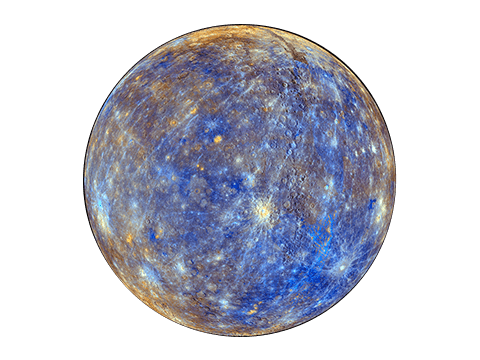Mercury is the closest planet to the Sun but, perhaps surprisingly, it does not have the highest temperatures. It is the second densest planet of the Solar System, but also the smallest planet. The structure of Mercury makes it the most similar planet to Earth.
Keys Facts & Summary
- Since Mercury can be seen without the need of a telescope, many ancient civilizations saw the planet, and as such it is impossible to determine who discovered it first. However, it was first observed with the help of a telescope in early 17th century, by Galileo Galilei.
- Galileo’s crude telescope didn’t manage to capture Mercury’s phases, this would be observed later by astronomer Giovanni Zupi in 1639, and thus he discovered that the planet had similar phases like Venus and the Moon.
- In ancient times, Mercury was taught as being two different objects in the sky: The Mourning Star and The Evening Star. In Venus’s case, it was also mistakenly believed to be two different things.
- Venus spends most of its time away from Earth. This paradoxically makes Mercury the closest planet to Earth, a plurality of the time. Mercury was named after the Roman messenger god, because of its fast movements around the Sun.
- Mercury is the closest planet to the Sun at a distance of 57.91 million kilometers / 35.98 miles or 0.4 AU away. It takes sunlight 3.2 minutes to travel from the Sun to Mercury.
- Despite its closeness to the Sun, it is not the hottest planet, that title belongs to Venus but Mercury is the fastest planet, completing a trip around the Sun in 88 Earth days. This also makes one year on Mercury the equivalent of 88 Earth days, the shortest year of any planet.
Mercury
One of the earliest known recorded observations of Mercury is the Mul.Apin tablets. It is believed that these observations were made by an ancient Assyrian astronomer around 14th century BC. The name used in these tablets is translated as “the jumping planet”.
Some Babylonian records date back to the 1st millennium BC. They called the planet Nabu, after the messenger to the gods in their mythology. The ancient Greeks knew the planet as Hermes while the Romans named it Mercury and it remained as such to this day.
Credits cannot be given to a single civilization or person because the planet has always been easy to spot on the sky. What we can do is to give credit to those who first studied the planet by more “modern” means such as Galileo Galilei in the early 17th century, and Giovanni Zupi who in 1639, observed that the planet had phases just like Venus and the Moon.
Formation
It is theorized that Mercury was formed about 4.5 billion years ago when gravity pulled swirling gas and dust together to form the small planet. Its small size but enormous core is theorized to be the result of a collision with another giant object that stripped much of its surface.
Distance, Size and Mass
Mercury is the closest planet to the Sun, at a distance of 57.91 million kilometers / 35.98 miles or 0.4 AU away. It takes sunlight 3.2 minutes to travel from the Sun to Mercury.
Mercury has a radius of 2.439 km or 1516 mi, and a diameter of 4.879 km or 3.032 mi. It is about the size of the continental United States, slightly bigger. It has a mass of about 3.285 × 10^23 kg or about 5.5% that of Earth.
Orbit and Rotation
Mercury's highly eccentric, egg-shaped orbit takes the planet as close as 29 million miles or 47 million kilometers, and as far as 43 million miles or 70 million kilometers from the Sun. It takes a trip around the Sun every 88 days thus 1 orbit/year is the equivalent of 88 Earth days. Mercury travels through space at nearly 29 miles or 47 kilometers per second, faster than any other planet.
Picture of Planet Mercury

Quick Facts
| Recorded By: | Assyrian astronomers |
| First Record: | 14th Century BC |
| Surface Temperature: | -173 to 427°C |
| Orbit Period: | 87.97 Earth days |
| Orbit Distance: | 57,909,227 km (0.39 AU) |
| Notable Moons: | None |
| Known Moons: | None |
| Equatorial Circumference: | 15,329 km |
| Polar Diameter: | 4,879 km |
| Equatorial Diameter: | 4,879 km |
| Mass: | 330,104,000,000,000 billion kg (0.055 x Earth) |











